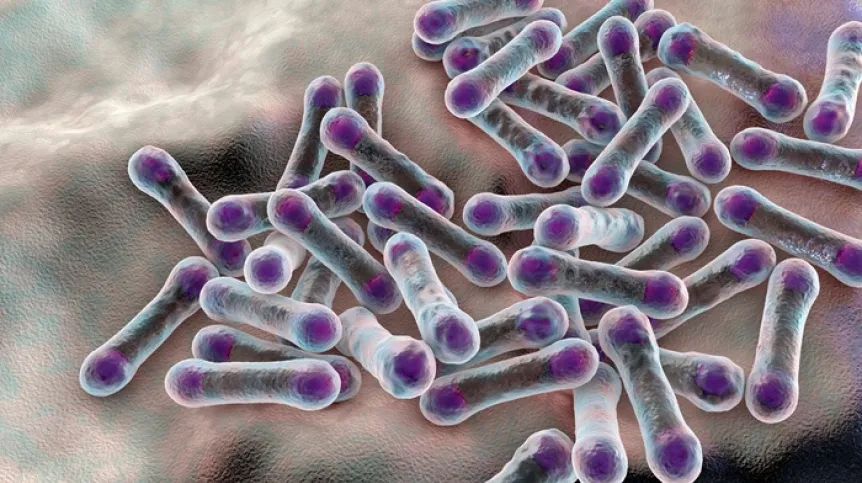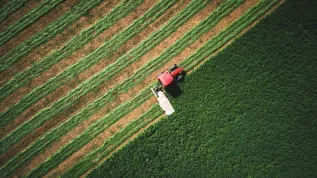
We can put bacteria to work to produce medicines, proteins and food, says Magdalena Janczewska from the Faculty of Chemical Engineering at the Warsaw University of Technology and co-founder of Science4Beauty, a company dealing with genetic modification of bacteria.
PAP: Bacteria are mainly associated with pathogens that cause dangerous diseases, but it turns out that people like you are not only able to tame them, but also put them to work.
Magdalena Janczewska: We can cooperate with bacteria because we live in symbiosis with them: we provide them with good conditions for life and growth, and they serve us as a natural bioreactor. And yes, we can put them to work.
PAP: A bioreactor?
M.J.: Yes, that is the key word, bacteria are a natural reactor that we can set - program in such a way that they produce a specific compound for us, in the case of our laboratory these are mostly proteins of various types, but not only that, bacteria can also produce other organic compounds.
PAP: What exactly do worker bacteria produce?
M.J.: For example, all the insulin produced industrially in the world is created thanks to the method of programming bacteria - they are encoded to produce it as their own protein. In addition to insulin, such programmed bacteria also produce human growth hormone. Remember that we also owe the discovery of many drugs to bacteria. For example, A soil bacterium that lives on a lonely island in the Pacific produces a drug without which transplantologists would not be able to do their work, it prevents rejection of transplants. Since this Polynesian island, which is their homeland, is called Rapanui, the drug was named rapamycin. These bacteria (Streptomyces hygroscopicus) also produce many other interesting substances studied as potential anticancer drugs, immunosuppressants, natural pesticides.
PAP: Can any type of bacteria be put to work?
M.J.: Yes, although some are better suited for this and easier to work with. We work mainly with the Escherichia coli (E. coli) strain, which, while arousing mixed feelings, is very useful in the biotechnological production of proteins. In general, we owe many other interesting things to bacteria, starting with pickled cucumbers and cabbage. They also work in the production of alcoholic beverages - it is thanks to them that some types of Japanese sake are produced. But that is not all - we force bacteria to clean our sewage, there are also strains that 'eat' unnecessary plastics. And vice versa - we can force bacteria to make plastics from municipal waste, i.e. from the so-called 'poop'. The longest cellulose chains, with the highest molecular weight, are also the work of these organisms, as is hyaluronic acid, which is widely used in medicine, including aesthetic medicine.
PAP: I will deviate a bit from the topic of the conversation, but in fact we owe our lives to bacteria.
M.J.: The average person hosts about 1.5 kg of bacteria, mainly in the digestive system. They produce vitamins for us, facilitate food digestion, sometimes they rebel if we eat improperly, but generally they sustain our life. They also influence our behaviour, because some strains promote depression, and others prevent it. Certain bacterial strains are responsible for wounds healing poorly, but there are also b strains, which greatly accelerate the healing of wounds. Knowledge about bacteria allows us to use them for good.
PAP: Does this mean that there are good and bad bacteria, the bad ones should be exterminated, the good ones will work for us?
M.J.: Not quite, because the aforementioned E. coli bacteria will produce vitamins B and K in the body under normal conditions, but in unfavourable conditions they can cause sepsis. Another example: no substance in the world is more toxic than botulinum toxin produced by the Clostridium botulinicum bacteria. Incidentally, they live not only in sausages, but also in honey. Therefore, when buying honey, pay attention to whether the lid of the jar is convex, as the bacteria produce gas during fermentation, which increases pressure and leads to convexity of the metal cap of the jar - if the lid is convex, do not touch it at all, because a teaspoon of such honey may be your last...
The toxicity of botulinum toxin is evidenced by the fact that its annual production is only a dozen or so grams, which satisfies the needs of all countries in the world. And yet humans can also use this toxin to their advantage. Of course everyone immediately thinks of aesthetic medicine, but it is also used to treat strabismus, bruxism, migraines, excessive sweating and problems with urination. Scientists are also working on diphtheria toxin ( produced by the bacteria - Corynebacterium diphtheriae), one molecule of which can kill dozens of our cells. We are thinking about the ways to use its deadly powers to kill only cancer cells.
PAP: How do you program bacteria?
M.J.: Bacteria are quite simple, they do not have such complex structures storing DNA as humans, so all you need to do is add to their basket a list of tasks in the form of additional DNA sequences that will make them start producing what we want. You make the appropriate sequences yourself or buy them (there are laboratories that specialise in this), then multiply them and give them to selected bacteria together with various additives - such as a gene for resistance to a selected antibiotic.
In the simplest version, we throw this DNA into a test tube with bacteria, take a piezoelectric lighter and do a click, click - as a result of high voltage, the phenomenon of electrostriction, the cell membranes of the bacteria into which this DNA enters open - this is a phenomenon of electrostriction that temporarily perforates the cell membranes. It is enough for the DNA to enter one, then we multiply it in the quantities we need. Of course, we use professional equipment for this purpose, but the principle is similar...
PAP: How will you know which bacteria have 'swallowed' the DNA offered to them?
M.J.: I mentioned that we add an antibiotic resistance gene to the DNA, right? So all you need to do is add a bit of antibiotic to the medium and the bacteria that survive are 'ours'. Then you have to give them some time and food - they double their numbers every few hours - and they are ready to work. This is a self-propelling mechanism, what they need is oxygen and a medium. Different bacteria require different food, some are gluttons for glucose, others need a poorer medium, then they have a greater motivation to survive and grow faster.
PAP: I know that despite being so versatile, bacteria are mainly used to produce proteins. Can they be programmed to produce meat?
M.J.: Proteins are many more things than we think and associate. If it were not for them, no reaction could occur in our body - for example, enzymes are also proteins of various types, they are the basic stimulus for chemical reactions occurring in our cells.
On the other hand, meat, i.e. muscles, consists of a set of thousands of proteins, the most well-known are myosin fibres and myoglobin, responsible for storing oxygen in red muscles. We also have a wonderful protein, which is haemoglobin - very toxic, by the way, because it produces free radicals. It consists of haem, a polycyclic non-protein structure surrounded by protein, which is similar in plants - the green one is also haemoglobin, only with magnesium, and in humans it is red, because it has iron, and in some Arctic fish, which have blue blood, magnesium and copper are added.
However, not every bacterium is able to produce every protein, some protein structures are too large and too complex, and bacteria are not always able to produce them. Many laboratories around the world are working on using bacteria to produce 'artificial meat', the problem for now is the proper purification of the product. Currently, work is being carried out on the production of human albumin by bacteria.
PAP: And what are your favourite proteins?
M.J.: Some of my favourite proteins are conotoxins., These are peptides, several dozen times smaller than botulinum toxin, originally present in the venom of predatory sea snails of the Conus species inhabiting tropical coral reefs and used to immobilise prey. We chose one of these proteins, conotoxin, which relaxes skeletal muscles by blocking ion channels, and use these properties to create a new generation cosmeceutical that effectively smoothes facial wrinkles. In addition, our formulation also contains a so-called transition promoter, which helps it penetrate the skin, which further increases the anti-wrinkle effect. Despite the fact that it is a natural toxin, the solution is safe.
PAP: And bacteria produce this conotoxin for you?
M.J.: Yes, these are non-pathogenic E. coli bacteria that we program appropriately at the DNA level. We obtain recombinant conotoxin by expressing the gene encoding this protein in E. coli bacteria. The molecule of our peptide is identical to the one produced naturally by Conus snails, but we have also managed to develop improved versions of this natural toxin.
Another conotoxin, the one that blocks calcium channels on neurons, is already used in medicine, it has analgesic effects. It is administered to the spinal cord of terminal patients as an alternative to morphine, because it is not addictive and it is a much more effective painkiller, even in very small doses.
But that is not all. The venom of Conus snails also contains proteins that may be potential drugs for diabetes, because they open channels that transport glucose into cells. There are also other proteins that can block nicotinic receptors, which opens up new possibilities in the fight against addiction.
We are also testing toxins from the venom of various organisms for other properties, such as inhibiting excessive sweating. Traditional deodorants act as physical blockers, simply plugging pores, and we intend to create a biological 'plug' using our bacteria. We are cooperating in this area with CEZAMAT Laboratories of the Warsaw University of Technology, we are applying for EU funding, and we have also established cooperation with a university in Belgium that specializes in research on neurotoxins. We are full of hope for success.
Interview by Mira Suchodolska (PAP)
mir/ mhr/ kap/
tr. RL













